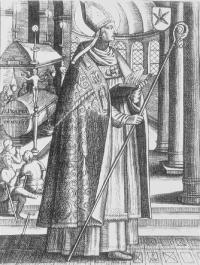Advent
Advent is a season observed in many Christian churches as a time of expectant waiting and preparation for both the celebration of the Nativity of Jesus at Christmas and the return of Jesus at the Second Coming. Advent is the beginning of the liturgical year in Western Christianity.
Etymology[edit | edit source]
The term "Advent" is derived from the Latin word adventus, meaning "coming," which is a translation of the Greek word parousia, commonly used to refer to the Second Coming of Christ. For Christians, the season of Advent anticipates the coming of Christ from three different perspectives: in the flesh in Bethlehem, in our hearts daily, and at the end of time.
History[edit | edit source]
The origin of Advent is somewhat unclear, with various practices of preparation for Christmas having been observed since the fourth century. However, it was not until the sixth century that the Roman Christian Church formally instituted Advent as a period leading up to Christmas. Initially, Advent was a period of fasting and penance, similar to Lent, which precedes Easter. Over the centuries, its observance has varied in practice and duration.
Observance[edit | edit source]
Advent is observed over the four Sundays leading up to Christmas. The exact practices and length of the Advent season can vary among different Christian denominations. Traditionally, Advent is marked by a spirit of expectation, anticipation, preparation, and longing. There is a dual focus on the past—the ancient waiting for the Messiah—and on the future, the coming of Christ at the end of time.
Advent Wreath[edit | edit source]
One of the most common Advent symbols is the Advent wreath, a circular garland of evergreen branches representing eternity. On that wreath, four candles are arranged. A new candle is lit on each of the four Sundays leading up to Christmas. Each candle represents an aspect of the spiritual preparation for the coming of the Lord, Jesus Christ.
Themes[edit | edit source]
Each week of Advent is traditionally dedicated to a specific theme, often hope, peace, joy, and love. These themes may be represented by the candles on the Advent wreath. In some traditions, a fifth candle is placed in the center of the wreath and lit on Christmas Day to celebrate the arrival of Christ.
Liturgical Color[edit | edit source]
The liturgical colors of Advent are purple and blue. Purple is traditionally used in most churches to symbolize penance, preparation, and sacrifice; however, some churches use blue, symbolizing hope and expectation, which is believed to be the original color of Advent.
Cultural Observances[edit | edit source]
In addition to religious observances, Advent has various cultural traditions associated with it. These include the Advent calendar, a special calendar used to count or celebrate the days of Advent in anticipation of Christmas. Advent calendars range from simple paper or cardboard calendars with windows that open to reveal an image or Bible verse, to more elaborate versions with small gifts or chocolates hidden behind each door.
Conclusion[edit | edit source]
Advent remains a significant season for many Christians around the world, a time of reflection, preparation, and anticipation for the birth of Jesus Christ and the hope of His return. It serves as a reminder of the spiritual journey of Advent, not just as a prelude to Christmas but as an important season of the Christian liturgical year in its own right.
This article is a Christianity-related stub. You can help WikiMD by expanding it!
Search WikiMD
Ad.Tired of being Overweight? Try W8MD's physician weight loss program.
Semaglutide (Ozempic / Wegovy and Tirzepatide (Mounjaro / Zepbound) available.
Advertise on WikiMD
|
WikiMD's Wellness Encyclopedia |
| Let Food Be Thy Medicine Medicine Thy Food - Hippocrates |
Translate this page: - East Asian
中文,
日本,
한국어,
South Asian
हिन्दी,
தமிழ்,
తెలుగు,
Urdu,
ಕನ್ನಡ,
Southeast Asian
Indonesian,
Vietnamese,
Thai,
မြန်မာဘာသာ,
বাংলা
European
español,
Deutsch,
français,
Greek,
português do Brasil,
polski,
română,
русский,
Nederlands,
norsk,
svenska,
suomi,
Italian
Middle Eastern & African
عربى,
Turkish,
Persian,
Hebrew,
Afrikaans,
isiZulu,
Kiswahili,
Other
Bulgarian,
Hungarian,
Czech,
Swedish,
മലയാളം,
मराठी,
ਪੰਜਾਬੀ,
ગુજરાતી,
Portuguese,
Ukrainian
Medical Disclaimer: WikiMD is not a substitute for professional medical advice. The information on WikiMD is provided as an information resource only, may be incorrect, outdated or misleading, and is not to be used or relied on for any diagnostic or treatment purposes. Please consult your health care provider before making any healthcare decisions or for guidance about a specific medical condition. WikiMD expressly disclaims responsibility, and shall have no liability, for any damages, loss, injury, or liability whatsoever suffered as a result of your reliance on the information contained in this site. By visiting this site you agree to the foregoing terms and conditions, which may from time to time be changed or supplemented by WikiMD. If you do not agree to the foregoing terms and conditions, you should not enter or use this site. See full disclaimer.
Credits:Most images are courtesy of Wikimedia commons, and templates, categories Wikipedia, licensed under CC BY SA or similar.
Contributors: Prab R. Tumpati, MD





